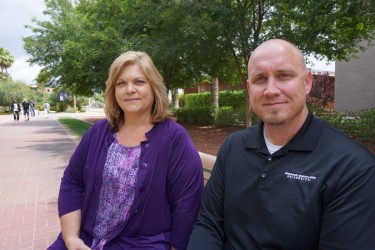By Michael Ferraresi
GCU News Bureau
With a presentation titled “Transparency in Higher Education,” Grand Canyon University assistant vice presidents Michelle Nuckols and Kirk Dykman are armed to showcase the systems that ensure GCU students have a clear understanding of their college costs.
Nuckols and Dykman, who oversee student operations, recently co-authored a white paper with that title and were invited to present their findings to hundreds of university officials during the annual conference of the National Association of State Administrators and Supervisors of Private Schools in Savannah, Ga.
Their presentation demonstrated GCU’s success with using proactive, no-nonsense methods of connecting students at the start of their ground and online degree programs with information on tuition, transfer credits, estimated funding and loan repayments.
Those tools include the GCU Degree Plan Net Price Calculator which helps online students precisely forecast what they’ll owe on their degrees down to the last administrative fee, an interactive U.S. map showing state requirements for program field placements and a database clearly identifying the validity of transfer credits.
GCU’s objective is to provide honest, understandable information to all prospective and current students, Nuckols said. The reactions she and Dykman received from surprised or impressed conference-goers in Savannah emphasized the uniqueness of GCU’s methods in the private, online higher education industry.
“I always tell our new hires, sometimes we are the lifeline for these students and we’re all the support they have,” Nuckols said.
“They depend on the information we’re providing for them to make good financial decisions, and that should come before they sign on the dotted line or take one step into a classroom,” she said.
Building trust with students is essential in an era of rising student loan debt and increasing competition among universities. To minimize student confusion, GCU established a full-service enrollment process, which includes thorough pre-evaluations of incoming students. Additionally, the University recently consolidated its online academic and financial advisers into a single role: student services advisers, or SSAs.
The University currently employs 213 SSAs who directly address student questions about academics and tuition, eliminating the need to pass them from one department to the next. Enrollment counselors also have been cross-trained on specific academic programs.
Counselors at some online-only universities face more inbound calls from concerned students than they make in outbound calls, but GCU’s counselors each make 20-30 outbound calls a day to check in with students and give them early opportunities to ask questions before they commit to a program, switch their majors or enroll in new courses.
“It doesn’t matter if you are an online school or a state school, if you have more inbound calls than outbound calls, you have a problem,” Nuckols said. “(GCU counselors) are constantly and proactively reaching out to the students, which was a little adverse to what we heard at the conference.”
Tools for transparency
Dykman said GCU aims to educate students about responsible borrowing, rather than leaving them to inaccurately guess what they’ll owe by the time they graduate.
According to the Institute for College Access and Success, more than 70 percent of 1.3 million students graduating from four-year colleges have student loan debt. The average debt for a graduating senior ranged from $29,400 to $39,950 in 2012, depending on the type of university from which they graduated, the institute reported.
In a 2014 report, The Washington Post analyzed data from the National Center for Education Statistics that showed Class of 2014 graduates averaged $33,000 in student loan debt. The New York Post reported earlier this month that as family members help their loved ones pay for college, “The results can be catastrophic” and “Credit profiles are destroyed, homes and retirements are put at risk, and families land in bankruptcy court” in extreme cases.
GCU advisers use the Net Price Calculator for online students and detailed budget sheets for ground students to clearly identify their financial obligations after scholarships, federal and state grants and federal loans. But the University goes a bit further than many of its competitors by encouraging students to borrow only the bare minimum, rather than the maximum allowed by the government, in order to complete their degree. That can mean significant savings for many students and their families.
“So in this example,” Dykman said, pointing to the slides he and Nuckols presented in Savannah, “it is (more than) $67,000 for total indirect aid for five years (with the maximum allowable loan), versus $34,000 if you just take the direct costs associated with the program.”
The significant impact in this example, Nuckols noted, is loan repayment savings of $357 per month.
That example cited a total cost savings of $33,806 if the loan amount is limited to what the student actually needs to complete his or her degree.
Mapping, charting details for students
GCU’s state compliance map is an effective tool for counselors to help students in nursing, education and counseling identify the specific requirements in the states where they’d like to work, since requirements for certifications and practicum work often change.
“Most state schools, they don’t have to care about that because people are coming to their university in their state,” said Dykman, who added that the digital map is updated often with fresh data from all 50 states.
“We have people who live in other states and want to work in other states,” he said. “If they want to be a licensed teacher or counselor, for example, after graduating — we’d better be right.”
The Transcript Evaluation Application database, or TEA, provides detailed information that counselors can relay to students. The digital tool compares data from more than 488,000 courses at more than 1,100 institutions, ranging from local community colleges to state universities, to draw comparisons with GCU courses.
The database gives students a clear picture of which credits will transfer to GCU and what else they can expect to need throughout their degree programs.
Lasetta Holden, a 37-year-old mother of two who recently enrolled in GCU’s online psychology master’s program, was pleasantly surprised about the details her enrollment counselor provided. The Glendale resident said she wanted to keep going with her online education after earning an online bachelor’s degree from another university, but that earlier experience had some snafus.
Students, state officials see difference
“I had a lot of problems with my financial aid, my financial advisor would submit my information late, just a lot of different things,” said Holden, who works in human resources at the U.S. Department of Veterans Affairs and also with special-needs children at her second job.
“But when I spoke with Grand Canyon, they were giving me information before I could even ask,” she said. “They told me everything right then and there.”
The Net Price Calculator helped her see what she would owe out of pocket and the required coursework.
“I have it at my desk,” she said of the calculator. “It’s like my little motivational tool. It breaks down what it’s going to cost and what I’m expecting to spend through the whole degree process.”
Dykman and Nuckols said they were pleased with the positive feedback from attendees at the Savannah conference.
“I just appreciated the work that has been done to best inform students about what their financial obligations may be, could be and will be,” said Julie Woodruff, a board member of the National Association of State Administrators and Supervisors of Private Schools and assistant executive director of postsecondary school authorization and lead attorney for the Tennessee Higher Education Commission.
Woodruff said Dykman and Nuckols’ presentation demonstrated how tools such as the transcript-evaluation database and the consolidation of counselors into the SSA roles can reduce common student complaints, among them, “I didn’t get what I bargained for,” and “No one told me I was going to have to retake these three classes.”
Woodruff added, “I think having that single point of contact really makes a lot of sense. We all get frustrated, whether it’s dealing with a government agency or a cell phone provider … No one wants to be put off or have to go through four or five people.”
Reach Michael Ferraresi at 602-639-7030 or [email protected].




